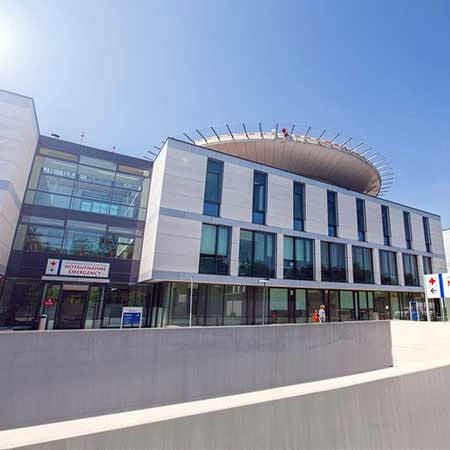Multiple myeloma is a tumor, which develops from cells that make antibodies. These are plasma cells, which are altered B lymphocytes. Multiple myeloma affects the bone marrow, displaces normal cells, and disrupts a hematopoietic function. This also damages bones, causing pain and fractures. Due to an excess of antibodies in the blood, some patients have their kidneys affected.
Hospitals in developed countries successfully treat multiple myeloma. Doctors use the latest drug therapy regimens that allow them to transfer the disease into a state of remission for many years. The remaining tumor foci are destroyed by radiation whenever required. In complex cases, oncologists resort to stem cell transplant procedures and use CAR T-cell therapy.
Content
- Drug therapy
- Radiation therapy
- Stem cell transplant
- CAR T-cell therapy
- Where to undergo myeloma treatment?
Drug therapy
Multiple myeloma is usually treated with drugs.
Chemotherapy used to be the main treatment in the past. This is still considered a first-line method in countries with poorly developed medicine. However, in developed countries, it plays an increasingly smaller role in the fight against myeloma, as new and more effective drugs have appeared.
Doctors use the following drugs for multiple myeloma:
- Cytostatics are conventional chemotherapy agents that block the division of cancer cells.
- Corticosteroids are anti-inflammatory drugs. They help to fight the manifestations of multiple myeloma and reduce nausea due to chemotherapy.
- Immunomodulatory drugs help the immune system to fight cancer. They are often used during a remission to prevent the disease recurrence.
- Proteasome inhibitors block enzymes important for cell division. They are mainly used for maintenance therapy after achieving a remission.
- Monoclonal antibodies are drugs that target particular molecular targets (antigens) found in cancer cells. CD38 or SLAMF7 antibodies are used to treat multiple myeloma. They help the immune system to better find and destroy cancer cells.
- Antibody-drug conjugates are monoclonal antibodies to which a chemotherapy agent is attached. Antibodies deliver drugs directly to cancer cells by interacting with the BCMA protein. They release drugs, damaging the tumor and having minimal effect on healthy cells. Antibody-drug conjugates are not considered a first-line therapy. These are used if at least 4 other treatment options have already been tried.
- Nuclear export inhibitors block the XPO1 protein, which transports other proteins from the nucleus to the rest of the cells. If it is blocked, transport stops and the cancer cell dies.
Multiple myeloma can rarely be treated with a single drug. Doctors usually use combinations of two or three drugs. If they do not work, oncologists try other options. Sometimes they prescribe four (DCEP), six (DT-PACE), or even seven drugs at the same time to achieve a remission of the disease.
A treatment regimen usually includes maintenance and symptomatic treatment:
- Bisphosphonates do not affect the rate of progression of myeloma, but help to strengthen the bones. They relieve pain and reduce the risk of fractures.
- Intravenous immunoglobulins are used to strengthen the immune system. They reduce the risk of developing infections of the lungs, paranasal sinuses, and other organs.
- Transfusions of blood and its components involve the administration of red blood cells for anemia. If there are problems with blood clotting, a platelet mass is administered to patients.
- Plasmapheresis is a procedure, in which a patient's blood is passed through a special device. This removes excess antibodies, which are produced in the body due to multiple myeloma.
Radiation therapy
Only a small number of patients with multiple myeloma need radiation therapy. In most cases, doctors can achieve a good result with the help of drug therapy alone.
Irradiation can be used in the following cases:
- for solitary plasmacytoma, as the main treatment option (this disease precedes multiple myeloma, and is characterized by the development of single tumor foci in the bones, less often in other organs);
- for irradiation of single foci of multiple myeloma that did not disappear after chemotherapy;
- if you need a quick result in case of complications, such as spinal cord compression (chemotherapy can also reduce a tumor size, but it works more slowly).
Healthcare professionals in developed countries use modern types of radiation therapy, which deliver radiation to tissues very precisely, without causing serious complications.
Stem cell transplant
A bone marrow transplant can be used in cases where other treatment options do not work. There are two transplant options:
- autologous (transplantation of a patient's own cells);
- allogeneic (stem cell transplant from a donor).
An autologous transplant is used to treat multiple myeloma. It is safer than an allogeneic one. In addition, patients do not have to look for a donor. Autologous transplantation procedures provide a long-term remission of the disease.
The essence of this treatment option is as follows:
- stem cells are harvested from the patient's bone marrow or peripheral blood;
- the patient receives high-dose chemotherapy, which destroys not only the tumor, but also the bone marrow, so the production of blood cells stops;
- the patient is transplanted with his own stem cells to restore hematopoietic function. Cells are administered intravenously.
Some doctors recommend their patients with multiple myeloma to have two autotransplant procedures from 6 to 12 months apart. Such an approach is called a tandem transplant. Trials show that they increase the patient's life expectancy and a relapse-free period as compared to a single transplant. However, this treatment method has a drawback: it causes more side effects. When having your consultation of the oncologist, check with him whether a tandem bone marrow transplant is suitable for you, or is it better to limit yourself to a standard procedure.
An allogeneic stem cell transplant (from a donor) for multiple myeloma is not considered a standard treatment. This can be used as part of clinical trials. This treatment option can be resorted to in the case of disease recurrence after an autologous transplant. The transplantation of stem cells from a donor is more dangerous, since the cells may not survive, and sometimes an immune reaction "graft versus host" occurs. However, if successful, this treatment is potentially more effective. First, donor cells are definitely free of myeloma residues. Secondly, after a successful transplant, the graft-versus-tumor effect is activated, so the remaining malignant cells in the body are destroyed.
CAR T-cell therapy
In complex cases, doctors abroad resort to CAR T-cell therapy. This is a type of immunotherapy that involves the use of T-cells with chimeric antigen receptors. Doctors take immune cells from a patient's blood, modify them, culture them, and inject them back into the body. The updated cells are more aggressive towards the tumor. They attack the areas of multiple myeloma spread, reduce them in size, and can even destroy them completely.
Two drugs have been approved for multiple myeloma treatment: Abecma and Carvykti (idecabtagene vicleucel and ciltacabtagene autoleucel), both targeting the BCMA protein, which is detected in myeloma cells.
This treatment method is expensive and may cause severe side effects, including cytokine release syndrome. To provide timely assistance in the case of complications, a patient is carefully supervised, which lasts the entire period of treatment and another 8 weeks. However, in most patients, the treatment is still successful, without any health consequences, and with good results.
Where to undergo myeloma treatment?
You can undergo your multiple myeloma treatment abroad, in one of the developed countries. You are welcome to use the Booking Health service to find a clinic. You can compare the cost of treatment in different medical centers and make your appointment at a favorable price.
There are a few reasons for you to undergo treatment abroad:
- doctors use the latest drugs instead of outdated chemotherapy regimens;
- high-quality accompanying treatment will avoid complications, reduce the number of side effects and allow the treatment to be carried out with less discomfort;
- even severe forms of myeloma are successfully treated: in the advanced stages, and in the absence of a response to standard treatment;
- you can undergo a stem cell transplant or CAR T-cell therapy abroad;
- specialists use modern types of radiation therapy, which affect the tumor with radiation, but almost do not irradiate healthy tissues, and therefore they rarely cause severe complications.
When making your treatment appointment through the Booking Health service, the cost of treatment for you will be reduced due to the lack of additional fees for foreign patients. You will receive insurance that protects against any unexpected medical expenses, so the initial price will not increase even if you need additional procedures. Please leave your request on the Booking Health website: our specialists will contact you, advise on all issues, help you to select a clinic, and arrange your trip abroad.
Authors:
The article was edited by medical experts, board certified doctors Dr. Vadim Zhiliuk and Dr. Sergey Pashchenko. For the treatment of the conditions referred to in the article, you must consult a doctor; the information in the article is not intended for self-medication!
Sources:
National Library of Medicine
NHS
MedicineNet










